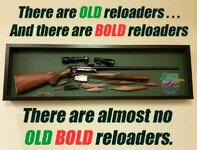willfrye027
WKR
- Joined
- Dec 4, 2018
- Messages
- 2,887
This is lapua 30-06 brass with essentially a bore rider bullet no real load data out there. In a tikka action, older t3 that is smoother and must have tighter tolerance than any of my newer ones.Does your hot load show any signs of pressure, or did it go from no signs straight to a locked up bolt? Was it just as likely to screw up the trigger or roast the firing pin or get a case stuck? What action are you using?
It’s a half grain below ejector marks…but a piece of lapua brass only lasts 4-5 firings. That was really my biggest clue that I’m way up there in pressure.
Blew the primer out and had to basically hammer the bolt open. Some gas cutting on the bolt face..but also not the first time I’ve blown a primer. It seems to hide pressure well for whatever reason. Has not seemed to affect accuracy or subsequent function.
When I’ve settled on a load I do like to reload one or two pieces over and over to make sure I’m getting the longevity I need. I hardly ever shoot that 30-06 except at game animals so it didn’t bother me too much…but next time I load more of that I’ll drop a grain at least.

